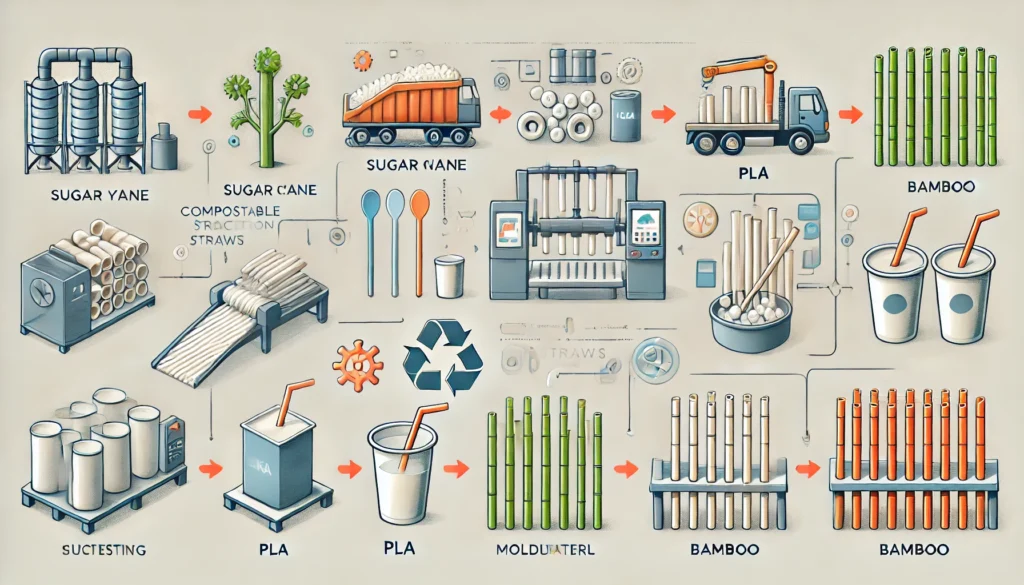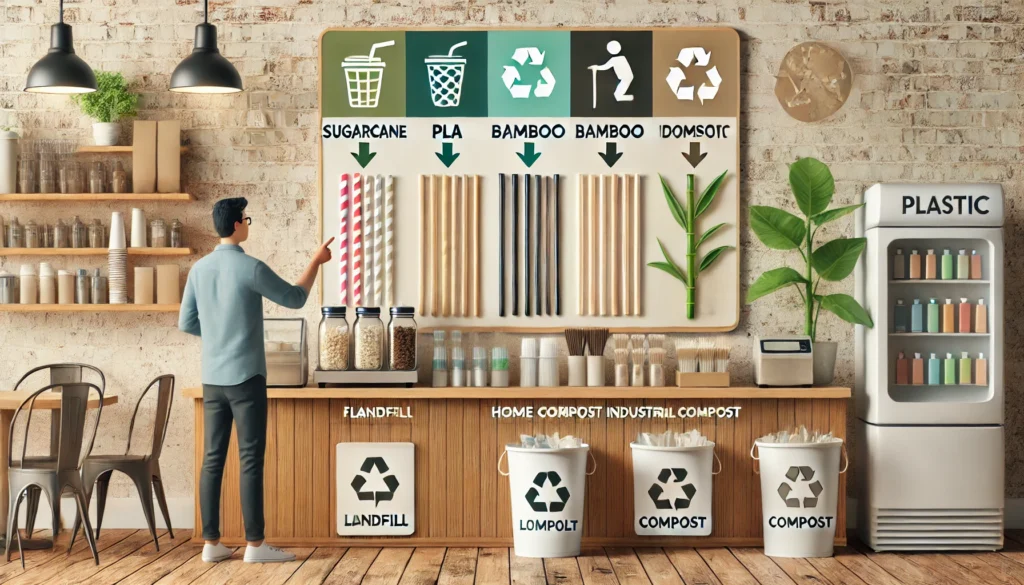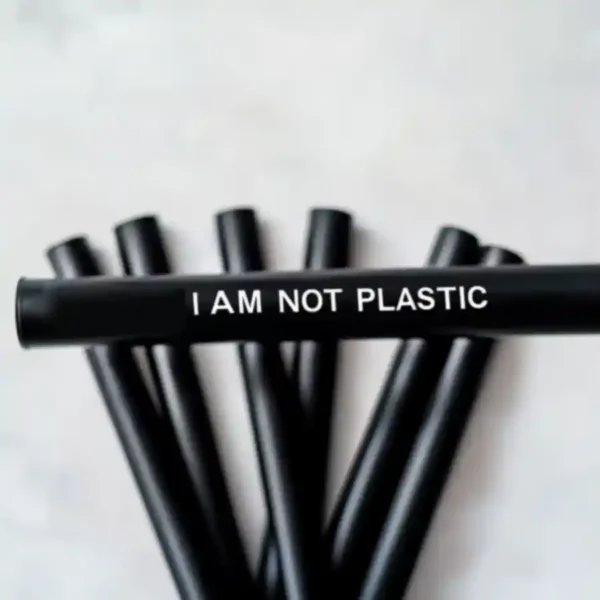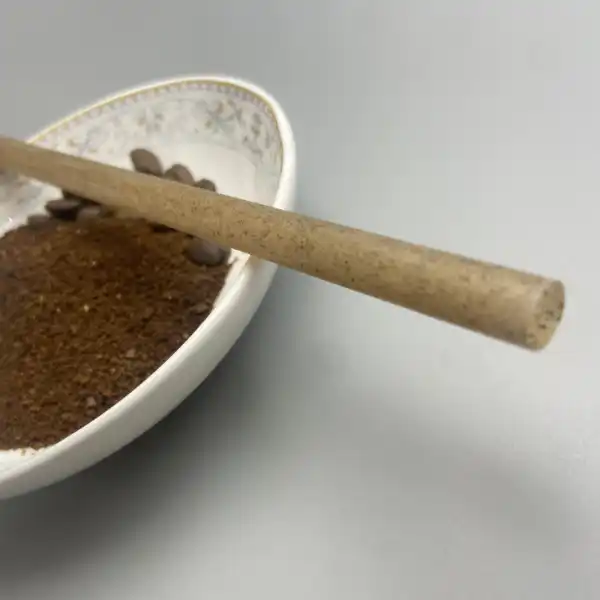
I. Introduction
“Every minute, the world uses over 1 million plastic straws. By the time you finish reading this sentence, another 5,000 will have been discarded—many ending up in oceans, landfills, or worse, your next seafood dinner.”
Compostable straws promise a guilt-free sip, but their environmental impact hinges on more than just swapping materials. From the energy used in production to the harsh reality of decomposition, these alternatives are only as “green” as their entire lifecycle.

II. The Production Process
Raw Materials & Manufacturing
- Materials: Sugarcane bagasse (a byproduct of sugar refining), PLA (corn-based plastic), and bamboo dominate the market.
- Process:
- Sugarcane straws: Pulp is molded using heat and pressure, avoiding synthetic adhesives.
- PLA straws: Corn starch undergoes fermentation to create polylactic acid, which is then extruded into straws.
- Sustainability Factors:
- Energy use: PLA production emits 60% less CO₂ than traditional plastic but requires industrial-scale composting to degrade.
- Byproducts: Bamboo straws often use chemical treatments for durability, contradicting eco-claims.
Case Study:
TerraStraw uses sugarcane waste from Thai farms, reducing agricultural burn-off by 30% in partner regions.
Data:
- Carbon Footprint Comparison (per 1,000 straws):
- PLA: 12 kg CO₂
- Sugarcane: 8 kg CO₂
- Plastic: 25 kg CO₂
(Source: Environmental Research Journal, 2023)
Expert Insight:
Dr. Lena Chen, materials scientist at MIT: “PLA’s Achilles’ heel is infrastructure—without industrial composters, it’s just slow-release pollution.”

III. Distribution and Consumer Usage
Logistics & Packaging
- Most compostable straws ship in recycled paper sleeves, but some brands use plastic-lined packaging to prevent moisture damage—a sustainability paradox.
Usage Realities
- Single-Use Myth: 68% of consumers reuse compostable straws despite manufacturers advising against it, risking microplastic ingestion from degraded materials.
- Heat Resistance: Bamboo straws tolerate boiling water, while PLA softens at 50°C, making them useless for hot drinks.
Case Study:
EcoSips partners with zero-waste cafes in Berlin, where straws are collected weekly for composting, achieving a 92% return rate.
Data:
- Consumer Survey: 41% of users mistake “biodegradable” for backyard compostable. (Source: Greenpeace Consumer Report, 2023)
IV. End-of-Life: Decomposition Process
Composting Conditions
- Industrial vs. Home:
- Industrial: Maintains 60°C for 10 days, breaking down PLA in 6 months.
- Home: Rarely exceeds 40°C, leaving PLA intact for years.
Decomposition Stages
- 0-30 Days: Microbial activity softens materials.
- 30-90 Days: Sugarcane straws fragment; PLA remains structurally sound.
- 90+ Days: Only 17% of PLA degrades in home composts vs. 89% in industrial facilities.
Expert Insight:
Jamal Rivera, founder of Compost Now: “We’ve found ‘compostable’ straws intact after a year in backyard piles. Labels lie; certifications don’t.”

V. Conclusion
Summary:
Compostable straws aren’t a silver bullet. Their benefits depend on ethical production, consumer education, and waste systems that don’t yet exist globally.
Trend Forecast:
- 2025: Edible algae-based straws enter mainstream markets.
- 2030: EU mandates “compostability” labels to specify required facilities.
Actionable Steps:
- Verify Certifications: Look for BPI or TÜV Austria stamps.
- Demand Transparency: Email brands about supply chains and packaging.
- Advocate Locally: Push for municipal composting programs.
Final CTA:
“Next time you order a drink, ask: ‘What happens to this straw after I’m done?’ Tag us with your most awkward #StrawConversation screenshot.”
Frequently Asked Questions (FAQ)
1. Are compostable straws truly better than plastic straws?
Yes, but only if they are properly composted. If sent to a landfill, they may not break down as intended.
2. Can I compost PLA straws at home?
No, PLA straws require industrial composting conditions with high heat and microbial activity.
3. How long do sugarcane straws take to decompose?
Sugarcane straws decompose within 90-180 days under proper composting conditions.
4. Do compostable straws affect the taste of drinks?
Sugarcane and PLA straws generally do not affect taste, while bamboo may add a slight woody flavor.
5. Can compostable straws be reused?
They are designed for single use, but some consumers rinse and reuse them. However, durability and hygiene may be compromised.
6. Are compostable straws safe for hot drinks?
Sugarcane and bamboo straws withstand high temperatures, but PLA straws soften above 50°C.
7. What should I do with a compostable straw if I don’t have access to composting?
Try to dispose of it in an industrial composting facility or check for local composting services. Otherwise, it may not decompose effectively in a landfill.
8. Why are compostable straws more expensive than plastic ones?
Production costs, raw material sourcing, and lower economies of scale make compostable straws more expensive, but prices are expected to drop with increased demand.
Internal Links:
Explore our complete guide to eco-friendly straw options.
Curious about how to properly store your eco-friendly straws?
Dive deeper into the lifecycle of compostable materials.







